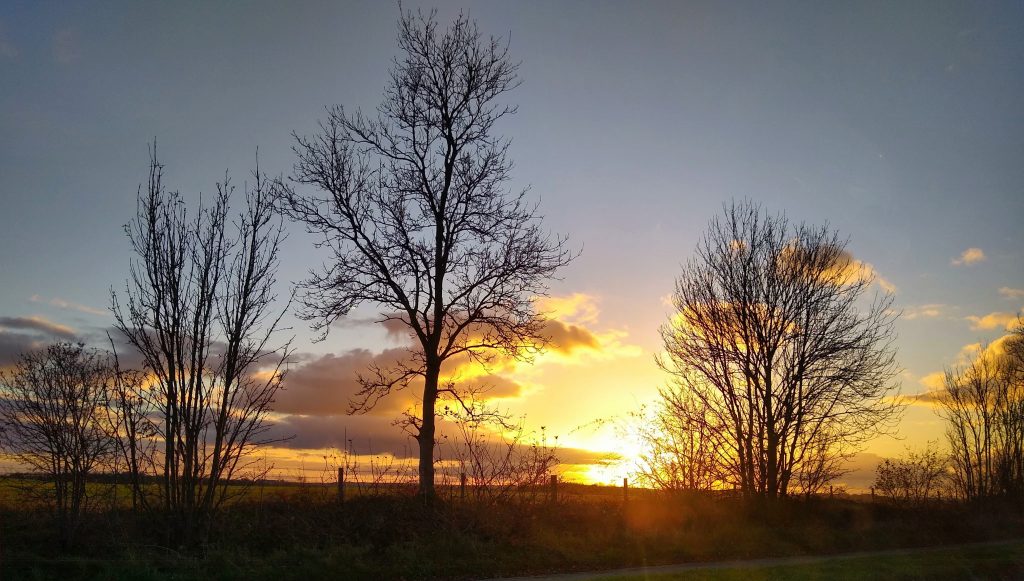Aren’t we blessed with the weather this autumn? So far we’ve seen endless sunny days, with good brief or overnight showers. Weed growth is rampant! But the October garden is changing colour rapidly now, leaves are falling, flowers are closing, and the shortening days mean that growth must come to an end soon.
The autumn garden is inevitably rather untidy, and I am mostly happy for it to be that way. Fallen leaves mulch the soil and gradually add their fibre; dead stems and branches provide shelter for myriad beings unseen. I cut back the worst of it, and clear paths for safety’s sake, but I leave plenty until spring too.

OCTOBER FLOWERS
Mine isn’t the sunniest garden, and flowers are starting to fade now, but the dahlias, Japanese anemones and erigeron are still going strong, and we’ve had a late, great show from a potted persicaria – I must try to find it a space in the garden next year. The echinops has managed a second round of flowers, and the bees are loving it on sunny days!

In other gardens, I see Michaelmas daisies and other asters are attracting the most bees. I will try to add some of them to the garden in time for next October too.
I’ve cut back the buddleia by about half, and will cut it lower (knee height or so) after the worst of winter. Lavatera can have the same treatment around now, to reduce wind rock over winter, and it’s a good time to trim dogwoods for shape and reduce the height of roses too. Many deciduous trees can be pruned now, as they enter dormancy, to remove damaged branches and adjust shape.
I’ve moved a lot of daffodil bulbs from containers and planted them in the new bed at the bottom of the garden. Other spring bulbs can be planted now too – except for tulips which are best left until November to avoid the risk of disease.

OCTOBER VEGETABLES
Ripening has slowed severely, so I’ve now picked the last of my tomatoes and chillies and put them in a sunny window to finish off, and consigned the plants (along with the courgette and cucumber plants) to the compost. It was great to have no tomato blight to contend with this year! Blight comes with rain and damp weather, so hot, dry summers are good news for outdoor tomato-growing.
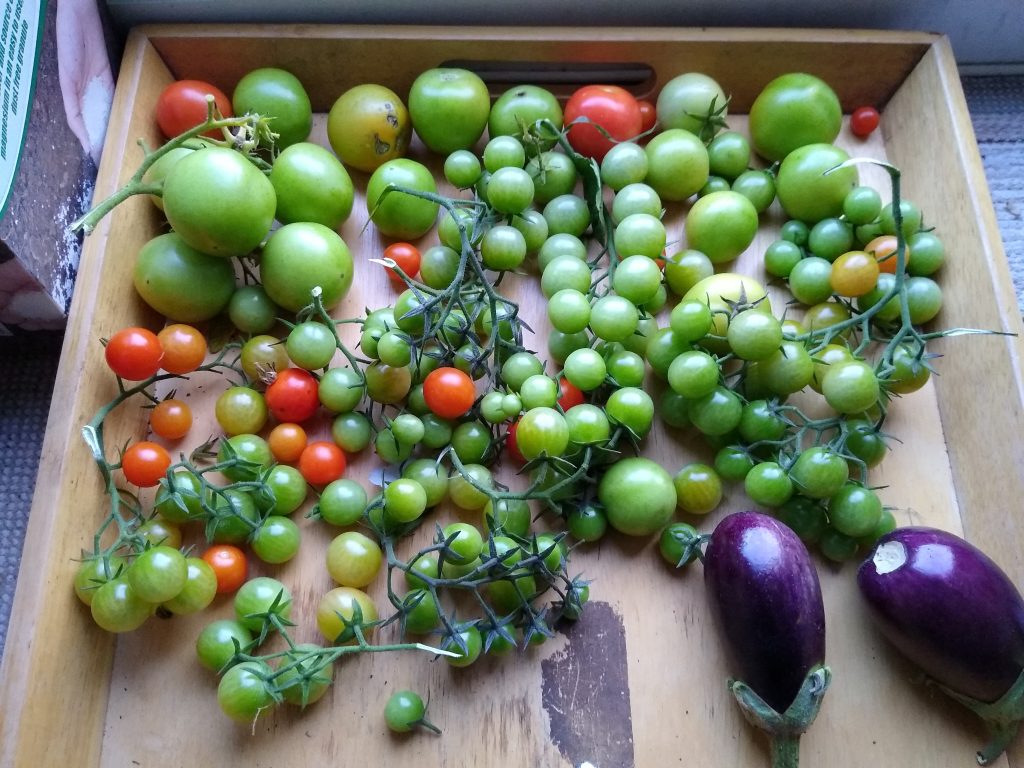
The two little aubergines are still not ripe either, and seem in no hurry… But I am in a hurry to use their space, so I picked them too. I’ve tucked them in a paper bag and I’m crossing my fingers they ripen a bit more.
The lettuce, broccoli, spicy salad and spinach seedlings sown last month are emerging well, though it seems unlikely any will be ready to eat before spring. It seems even the mildest, sunniest weather doesn’t quite make up for the shorter days in autumn.
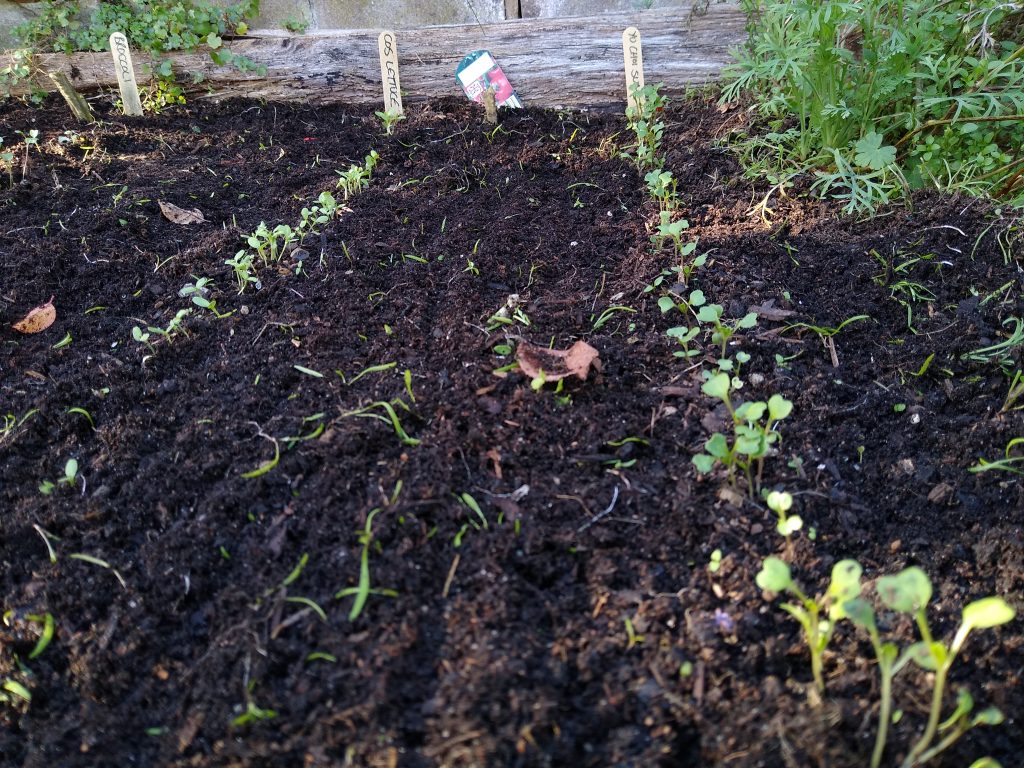
Self-seeded winter purslane and lamb’s lettuce are pushing through all over the veg beds. I tend to let them run wild, and only tear them out when they threaten to swamp other plants – they provide easy winter salads right through the dark months with almost no effort!
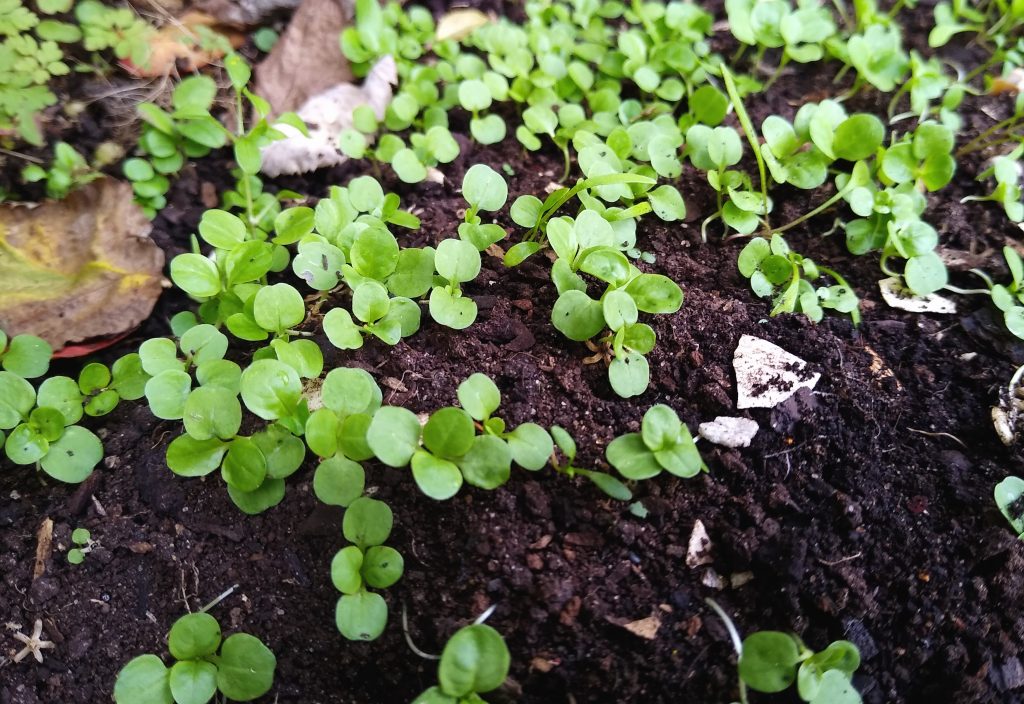
The saffron is flowering, and every morning I check to see if there are any new red stamens to harvest. After picking, they go into a little ramekin in my kitchen to dry. Saffron likes a good hot, dry summer, so I’m hoping for a good harvest! There are certainly plenty more buds on the way.

There’s not much to sow in the October veg garden, but I planted my garlic this week, in the raised bed, for harvesting in June. I plant them 15cm down, for bigger bulbs, and 15cm apart. Garlic seems a picky plant that needs just the right winter weather to do well, but after a brilliant harvest this summer my hopes are high!
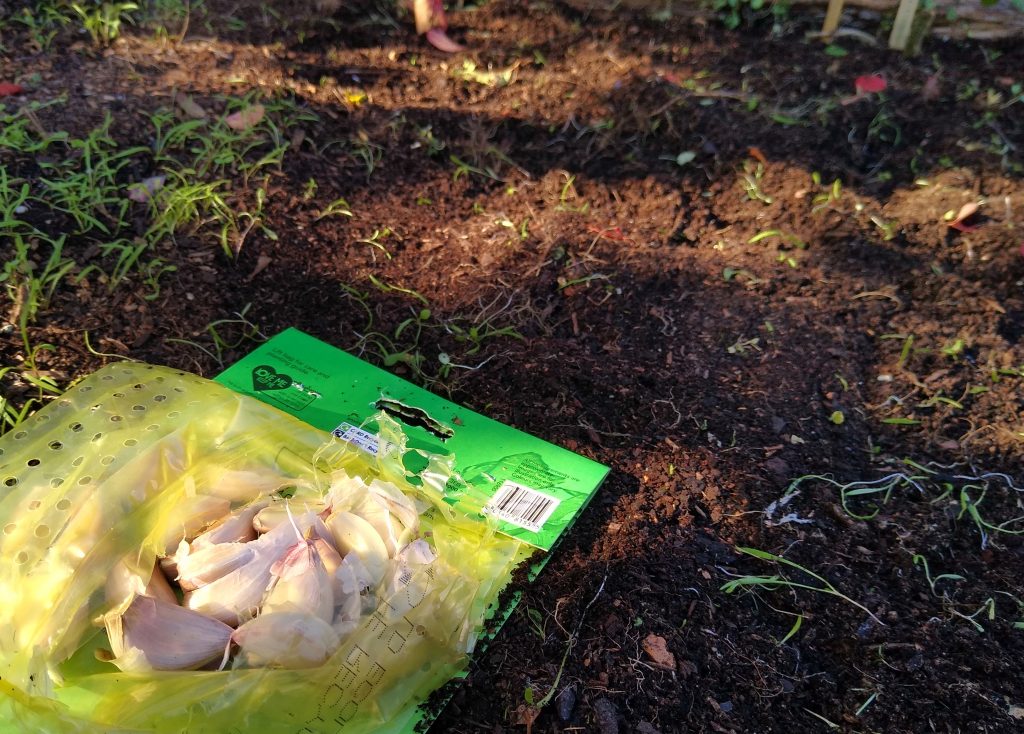
OCTOBER FRUIT
All my fruit is over for the year, and I’m amid cutting back the autumn raspberries and trimming the strawberries, removing dead material and old leaves to keep disease at bay, and removing unwanted suckers and runners to keep things tidy!
Oh! There is one fruit I haven’t mentioned. I have a Chilean guava plant in a pot, with unusual fleshy berries that ripen in early winter. I largely ignore it, but yet it provides a good crop each year and the birds don’t seem to go for the fruit. They’re an odd flavour, a little like strawberry and a little like pine. They look like they’re doing well, and I’ll be picking them late November and December.
OCTOBER WILDLIFE
We have reinstated the bird feeders (having taken them down a few weeks back when we spotted some bloated birds we suspected were diseased) and we’re enjoying again the usual mix of great tits, blue tits, greenfinches, robins and dunnocks, as well as a few more occasional visitors. Herons fly over more often at this time of year, and sometimes perch at the tops of nearby trees to survey the gardens below.
Butterflies become a rare sight in October, though I did see a brimstone in the garden yesterday, and bees are fewer and fewer. Common carder bees – a small type of bumblebee – usually stay the longest, remaining active right into November. Wasps, however, are abundant right now, and I’ve seen several active nests recently which seems really rather late – perhaps because of the extreme summer we’ve had. I like having lots of wasps in the garden; they remove the caterpillars from the kale so I don’t have to.
There are fallen leaves to be cleared from the pond, and the hedgehog house needs a new covering of leaves and branches before the cold sets in. Sadly, I haven’t seen any hedgehogs this year, but I will keep the garden ready for them in case they return.
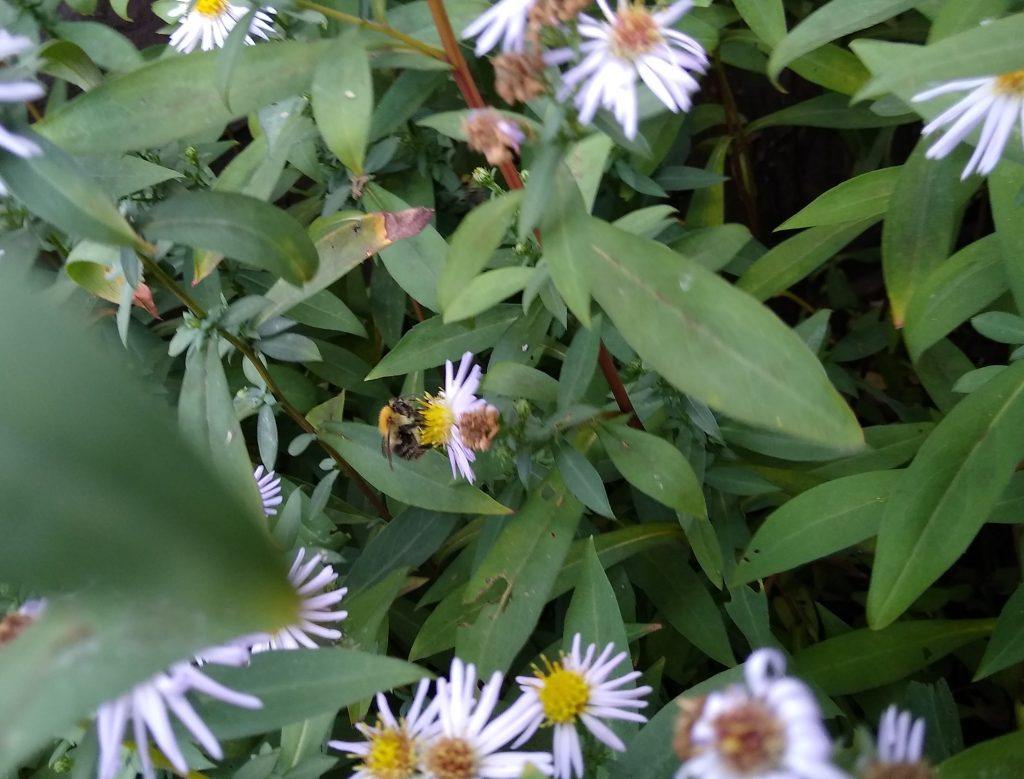
TOP JOBS IN THE OCTOBER GARDEN
- Continue deadheading, and harvesting late fruits.
- Cut back browning perennials – but consider leaving some for wildlife, or leaving the cut stems in a bundle out of the way for hibernating insects.
- Divide perennials (including rhubarb) and replant.
- Rake fallen leaves and, as long as they’re disease-free, collect them for leafmould or sweep them onto beds to mulch the soil and provide shelter for wildlife.
- You can still plant new plants if desired, and it’s a good time to prepare the ground for any bareroot plants you are planning.
- Prune buddleia, lavatera, and deciduous trees.
- Plant spring-flowering bulbs (except tulips).
- Protect tender plants – if you have tender potted perennials to bring into the conservatory or greenhouse, do it now, and have fleece or cloches ready to protect overwintering veg crops.
- Net brassicas to protect them from hungry pigeons.
- Mow lawns and trim hedges – this month is your last chance.
- If you plan to save any seeds for next year, and haven’t done it yet the time is now. If you have annual flowers that you want to self-seed, stop deadheading in late October and let the seeds disperse.
- Plant garlic. And plant out spring cabbages: if you haven’t started any seeds you may be able to buy them at your local nursery.
- Lots of people prune climbing roses now. I prefer to leave this until February, when the weather’s done its worst, the plants are bare and I can better see what I’m doing. However now is a great time to roughly tie-in new stems, while they’re still soft and bendy.
- Tidy up ponds and keep them clear of fallen leaves if possible.
- Feed birds and set up hedgehog houses. Provide wild places for invertebrates to overwinter.
MY FAVOURITE PLANTS FOR OCTOBER COLOUR
- Dahlia
- Rudbeckia
- Hylotelephium
- Japanese anemones
- Many hardy geraniums e.g ‘Rozanne’
- Verbena bonariensis
- Erigeron karvinskianus
- Fuchsia
- Aster, especially symphyotrichum
- Salvia ‘Hot Lips’
- Cyclamen hederifolium
- Hesperantha
- Vinca difformis e.g. ‘Jenny Pym’
- Ceratostimga plumbaginoides
- Cosmos (annual flower)
- Abelia (flowering shrub)
- Acer (foliage)
- Amelanchier (foliage)
- Cotinus (foliage)
- Virginia creeper (foliage)
- Cercis (foliage)
- Cornus (foliage, followed by bright winter stems)
- Euonymus alatus (foliage and berries)
- Rosa glauca (berries)
- Cotoneaster (berries)
- Holly (berries)
- Pyracantha (berries)
- Rowan (berries)
- Callicarpa (berries)
- Malus/crab apple (ornamental fruit)
- Liquidambar (foliage – large tree!)
CURRENTLY HARVESTING AND EATING
- Carrots
- Kale
- Tomatoes
- Chillies
- Aubergines
- Courgettes
- Swiss chard
- Parsley
- Woody herbs: rosemary, sage, bay, oregano, thyme, savory
- French scorzonera
- Saffron (for drying)
- Squash (from stores)
- Garlic (from stores)
WHAT ABOUT YOU?
How is your garden growing this October? Are you picking anything edible from your plot this week?
<< SEPTEMBER IN MY GARDEN
NOVEMBER IN MY GARDEN>>
LIKE THIS POST? PLEASE SHARE!



